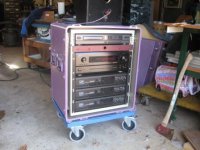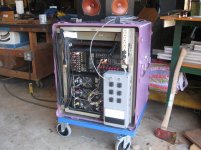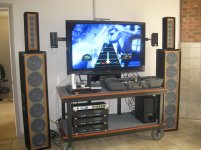AdamZuf said:I'm begining to like your idea 🙂
I'll go and search for 4->5" drivers.
We're talking about the bass woofers only, right?
Please tell me, knowlegable man, throughout this thread you talk in many terms that I yet to really understand (although I get the picture, just not some of the detail). Do you know a good site that explains all of these and how to put these terms into practice and calculation, like you do?
A simple example, I would like to calculate how much Watts each of them will have to play while within the array, if I got a certain number of them, required amp power and so on.
I wonder how good can a 5 drivers per side array sound in a small room, if a bit more money is spent for good drivers, woofers and tweeter.
Thanks for the help
Adam
For theory, including the math behind it, check out Dr Griffin's paper at http://www.diyaudio.com/forums/newreply.php
For some real world stuff about cheap drivers in a line array check out my friend Dmitri's site at http://www.geocities.com/dmitrynizh/labaffles.htm
A 4-5 driver array works great for a desktop because it's easy to stay within the plane of the array and it's nearfield response. In a room you need taller arrays and because you need the drivers as close together as possible, you need more drivers. Close spacing is essential so the higher frequencies are included in the line array effect.
The line array effect is based on frequency, driver spacing, and length of line. Higher frequencies require smaller spacing and shorter lines can project further. Low frequencies can have larger spacing and need longer lines. That's why spacing your bass units apart will work and is needed for the line array to project further. The two reasons I think you need so many drivers are: 1. You want long arrays, so your listeners remain in the nearfield as much as possible because tonality will change if they are in the nearfield at some frequencies and and farfield at others. 2. You want lots of drivers to achieve the efficiency and SPL that you need outdoors. Remember, you wouldn't build a speaker using one of these drivers except maybe for a desktop. If you put alot of them working together like ants, they can be impressive.
The tapping cones, etc. is for the woofers, because you are looking for low Fs. I would never consider a 4" driver a woofer.
For system power output requirements etc., it's best to invest in an SPL meter so you know what 1 driver can do. It's simple math once that is know. You could get away with estimating this if you already have some drivers of various known sensitivity and doing a comparison. Our ears are amazing measurement instruments it just takes a little training for them.
If you can find drivers you like for a great price in your area after listening to a wide selection, success is almost guaranteed. Cutting all those driver holes will be the worst part of the hole thing, so be prepared. My work on arrays has been more rewarding than all of my other speaker projects combined. This is due to all the hands on listening and evaluation, the knowledge gained, plus the end result is very unique and results in alot of feedback and interest from others.
First, find some decent drivers and build a mini array pair and see what kind of sound you can get for $20 or less. Keep in mind that the bass and top end may be missing, but those are easily obtainable too.
Here's the corrected link to Dr. Griffin's work.
http://www.audiodiycentral.com/resource/pdf/nflawp.pdf
http://www.audiodiycentral.com/resource/pdf/nflawp.pdf
Hello guys me and my friends made this Outdoor speaker: https://www.youtube.com/watch?v=llLS_k0QwOY
What do you think about it ? Got any experience on how to make speakers with theese horns yourself ? And do you know of any speakers with similar design ? If so please show them.
Thanks.
What do you think about it ? Got any experience on how to make speakers with theese horns yourself ? And do you know of any speakers with similar design ? If so please show them.
Thanks.
- Status
- Not open for further replies.
- Home
- Live Sound
- PA Systems
- Powerful speakers for the outdoors ??


